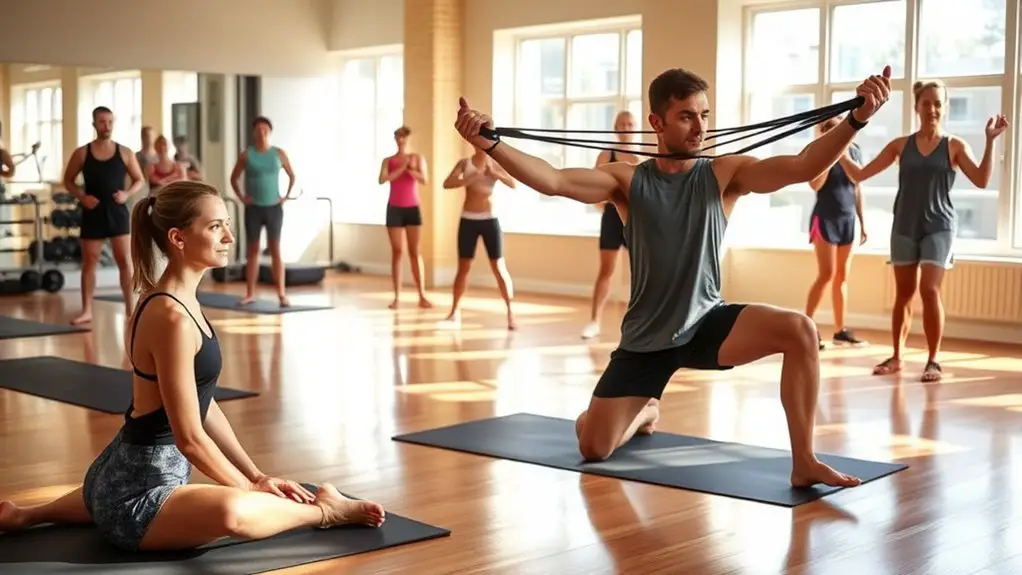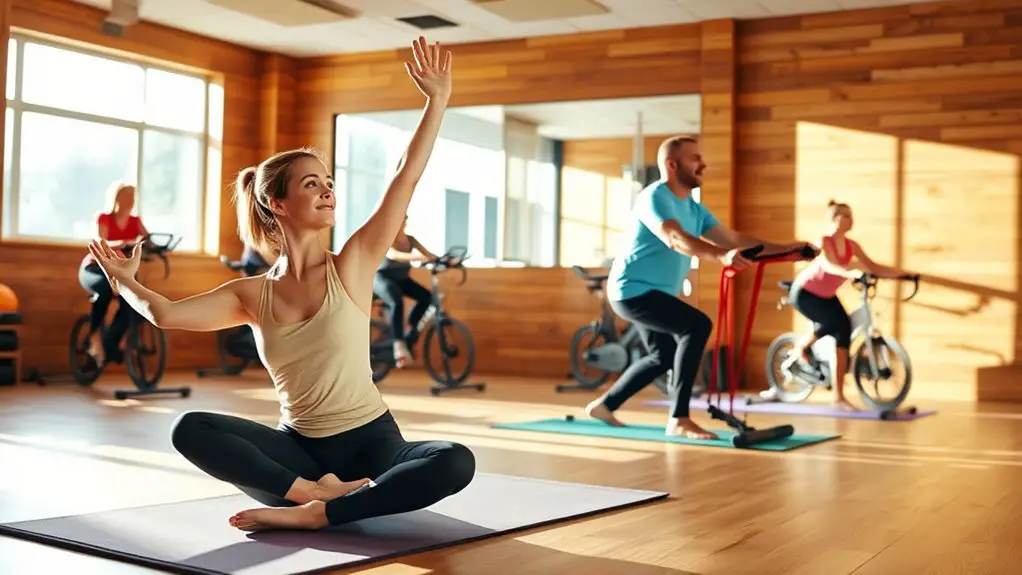The Benefits of Active Recovery Gym Workouts

Active recovery gym workouts are essential for your fitness journey. They help enhance blood circulation, reduce muscle soreness, and improve your range of motion. Engaging in low-intensity activities boosts your performance and stamina while supporting your mental health. You’ll feel more motivated and consistent when you incorporate these workouts into your routine. Plus, they can help you achieve your fitness goals more efficiently. Discover how to tailor active recovery to your needs and maximize its benefits!
Understanding Active Recovery

Active recovery can be a game-changer for your fitness routine, especially when you’re feeling worn out from intense workouts. It’s not just about taking a break; it’s a strategic approach to enhance your overall performance. Active recovery techniques include low-intensity activities like walking, yoga, or gentle cycling, which can help your body recover while keeping you engaged.
The benefits overview of active recovery emphasizes improved circulation, reduced muscle soreness, and enhanced flexibility. By incorporating these techniques, you’re allowing your body to repair itself without completely resting. It’s like giving your muscles a friendly nudge to recover faster and more effectively. Plus, you’ll feel more energized and motivated to hit your next workout with renewed vigor. So, don’t underestimate the power of active recovery—it can help you reach your fitness goals while keeping your body happy and healthy!
Enhancing Blood Circulation
Enhancing blood circulation is essential for your active recovery workouts. Better circulation means improved oxygen delivery to your muscles, which helps with faster recovery and performance. By focusing on this aspect, you can maximize your gains and feel refreshed for your next session.
Improved Oxygen Delivery
When you engage in active recovery workouts, you’re not just giving your muscles a break; you’re also boosting your body’s oxygen delivery system. These low-intensity exercises enhance blood flow, improving oxygen transport to your muscles. As your heart pumps more efficiently, it increases metabolic efficiency, allowing your body to utilize oxygen more effectively during future workouts. This means you’ll have better stamina and endurance when you hit the gym again. Plus, improved oxygen delivery helps clear out metabolic waste, keeping you energized and ready for your next session. So, don’t underestimate the power of active recovery; it’s a vital component in your fitness journey, ensuring you’re always primed for peak performance. Keep moving, and your body will thank you!
Faster Muscle Recovery
While you might think rest is the only way to recover after a tough workout, incorporating low-intensity exercises can greatly speed up muscle recovery by enhancing blood circulation. When you engage in active recovery, oxygen-rich blood flows to your muscles, delivering essential nutrients for repair. This process not only reduces soreness but also boosts overall performance.
| Benefits of Enhanced Circulation | How It Helps You |
|---|---|
| Increased Nutrient Delivery | Promotes muscle nutrition |
| Reduced Inflammation | Speeds up recovery techniques |
| Enhanced Flexibility | Improves overall mobility |
| Mental Well-being | Keeps you motivated and focused |
Reducing Muscle Soreness

After a tough workout, you might feel that familiar muscle soreness creeping in. The good news is that active recovery can boost blood circulation, enhance muscle repair, and reduce lactate buildup, helping you bounce back faster. By incorporating these strategies, you’ll not only feel better but also keep your fitness journey on track!
Increased Blood Circulation
Increased blood circulation plays an essential role in reducing muscle soreness, especially after intense workouts. When you engage in active recovery, you’re boosting blood flow to your muscles, delivering crucial oxygen and nutrients that promote muscle health. This enhanced circulation helps flush out metabolic waste products, like lactic acid, which can contribute to that post-exercise discomfort. By incorporating low-intensity activities, such as walking or light cycling, you can considerably improve your recovery process. It’s not just about resting; it’s about keeping your body moving to facilitate healing and reduce stiffness. So, next time you feel sore, remember that a little movement goes a long way in helping you bounce back stronger and ready for your next challenge!
Enhanced Muscle Repair
When you prioritize active recovery, you’re not just easing muscle soreness; you’re also enhancing the repair process of your muscles. Engaging in low-intensity activities like walking or yoga can stimulate blood flow, promoting muscle regeneration techniques that accelerate healing. By incorporating these ideal recovery strategies, you help reduce stiffness and discomfort after intense workouts. Remember, your muscles need time and care to repair effectively, and active recovery provides that. It encourages the body to flush out toxins while delivering crucial nutrients to the damaged fibers. So, don’t underestimate the power of a gentle workout; it’s a fundamental part of your fitness journey, ensuring you bounce back stronger and ready for your next challenge.
Reduced Lactate Buildup
Although you might not realize it, reducing lactate buildup is a crucial factor in minimizing muscle soreness after workouts. By engaging in active recovery, you can positively influence your lactate threshold and enhance metabolic pathways, allowing your body to clear lactate more efficiently. Here are some benefits of reducing lactate buildup:
- Decreased muscle soreness post-exercise
- Improved recovery times between workouts
- Enhanced overall workout performance
- Increased endurance during prolonged activities
- Better regulation of energy production
Incorporating light activities like walking or cycling into your routine can help flush out lactate and promote faster recovery. So, don’t underestimate the power of active recovery; it’s an essential component in your fitness journey that’ll keep you feeling great and ready for your next challenge!
Improving Range of Motion

To enhance your overall performance and prevent injuries, improving your range of motion is essential. Engaging in active recovery workouts can greatly boost your joint mobility, making everyday movements smoother and more efficient. Incorporating dynamic stretching into your routine not only warms up your muscles but also prepares your joints for a greater range of motion.
Focus on exercises that target all major joints, like arm circles, leg swings, and torso twists. These movements increase blood flow and flexibility, helping you to break through those stiffness barriers. Remember, a well-maintained range of motion can improve your athletic performance and reduce the risk of injuries during intense workouts. Additionally, incorporating light cardio exercises before stretching can further enhance the effectiveness of your warm-up routine.
Supporting Mental Health
While many people focus on physical recovery, supporting your mental health is just as essential for overall well-being. Engaging in active recovery workouts can greatly enhance your emotional resilience and promote mindfulness practices. Here are a few ways you can benefit:
Supporting mental health is crucial for overall well-being, making active recovery workouts a powerful tool for emotional resilience.
- Boosts Mood: Physical activity releases endorphins, which help combat stress and anxiety.
- Enhances Focus: Incorporating mindfulness practices during workouts improves concentration and mental clarity.
- Builds Emotional Resilience: Regular active recovery helps you adapt to stressors, making you more resilient in daily life.
- Creates Community: Participating in group workouts fosters social connections, reducing feelings of isolation.
- Encourages Self-Care: Prioritizing mental health during recovery promotes a holistic approach to your fitness journey.
Preventing Injury

When it comes to preventing injury, focusing on enhanced muscle recovery is key to keeping you in the game. Incorporating active recovery workouts can improve your flexibility and mobility, helping you stay agile and less prone to strains. Plus, by reducing muscle soreness, you’ll feel more motivated and ready to tackle your next workout with confidence.
Enhanced Muscle Recovery
Although muscle recovery often takes a backseat in workout routines, prioritizing it is vital for preventing injuries and enhancing overall performance. By focusing on enhanced muscle recovery, you can guarantee your body is ready for the next challenge. Here are some key strategies to incorporate into your routine:
- Stay hydrated: Proper muscle hydration is essential for recovery and performance.
- Incorporate active stretching: This helps improve blood flow and reduce stiffness.
- Listen to your body: Pay attention to signs of fatigue or discomfort.
- Utilize foam rolling: This can alleviate muscle tightness and promote circulation.
- Rest adequately: Don’t underestimate the power of a good night’s sleep.
Improved Flexibility and Mobility
Improving flexibility and mobility is essential not just for enhancing your performance but also for preventing injuries during workouts. By incorporating dynamic stretching into your routine, you can increase your range of motion, allowing your muscles and joints to function more efficiently. It’s a great way to warm up, preparing your body for the challenges ahead.
Additionally, foam rolling plays a vital role in maintaining flexibility. It helps release muscle tightness and improve blood flow, reducing the risk of strains. By making these practices a regular part of your active recovery, you’re not only enhancing your mobility but also setting yourself up for long-term success. So, get rolling and stretch it out—you’ll thank yourself later!
Reduced Muscle Soreness
To reduce muscle soreness and prevent injury, incorporating active recovery techniques into your routine is essential. These methods help maintain blood flow and promote healing, allowing you to bounce back quicker. Here are some effective strategies you can use:
- Foam rolling techniques: Target tight areas to release muscle tension.
- Gentle stretching: Enhance flexibility and reduce stiffness.
- Low-intensity cardio: Engage in light activities like walking or cycling to keep muscles active.
- Hydration: Drink plenty of water to flush out toxins and aid recovery.
- Restorative yoga: Practice poses that promote relaxation and blood circulation.
Boosting Performance

When it comes to boosting performance, incorporating active recovery gym workouts can make a significant difference in your training regimen. These workouts aren’t just about taking it easy; they’re vital for performance enhancement and strength improvement. By engaging in low-intensity exercises like yoga, light cycling, or swimming, you promote blood flow to your muscles. This increased circulation helps deliver nutrients and removes waste, allowing your body to recover more efficiently.
As you recover, you’ll find that your strength improves, enabling you to tackle more intense workouts. Plus, these sessions can help you mentally reset, which is important for staying motivated and focused. By making active recovery a regular part of your routine, you’re not only enhancing your current performance but also setting the stage for long-term gains. So, don’t underestimate the power of these workouts; they’re key to releasing your full potential!
Encouraging Consistency
Although staying consistent with your active recovery workouts can be challenging, finding a routine that works for you can make all the difference. To help you stay on track, consider implementing these motivation strategies alongside effective goal setting:
- Set clear, achievable goals: Break your long-term objectives into smaller, manageable milestones.
- Schedule your workouts: Treat your active recovery sessions like important appointments you can’t miss.
- Track your progress: Keep a journal or use an app to visualize your improvements, no matter how small.
- Mix it up: Incorporate a variety of activities to keep things fresh and exciting, so you’re less likely to get bored.
- Find a workout buddy: Exercising with someone else can hold you accountable and make workouts more enjoyable. Additionally, recognizing the need for rest days can be essential to avoid burnout and maintain motivation.
Tailoring Active Recovery to Your Needs

How can you make active recovery work best for you? It’s all about tailoring personalized routines that fit your unique needs. Start by evaluating your fitness goals—whether it’s increasing endurance, building strength, or enhancing flexibility. This will help you choose the right activities, like light jogging, yoga, or swimming, that align with your aspirations.
Listen to your body. If you’re feeling particularly sore, opt for gentler movements, while on days with more energy, you might push a little harder with dynamic stretches or cycling. Incorporating variety keeps things fresh and prevents boredom, so mix in different exercises throughout the week.
Incorporating Active Recovery Into Your Routine
Finding ways to incorporate active recovery into your routine can greatly enhance your overall fitness journey. By integrating these techniques, you’ll not only improve your recovery but also enjoy workout variations that keep things fresh and fun. Here are some simple ways to incorporate active recovery:
- Light cardio: Engage in activities like walking, cycling, or swimming at a low intensity.
- Yoga: Incorporate gentle yoga sessions to improve flexibility and relaxation.
- Dynamic stretching: Use light stretching to promote circulation and flexibility.
- Foam rolling: Spend time foam rolling to alleviate muscle tightness and soreness.
- Active hobbies: Enjoy leisurely activities like hiking or dancing that keep you moving without the strain.
Frequently Asked Questions
How Often Should I Incorporate Active Recovery Workouts?
You might think you need to crush your workouts every single day, but that’s not the secret sauce to success! Instead, consider incorporating active recovery workouts about 1 to 3 times a week. These sessions can help you feel rejuvenated while allowing your body to recover. Stick to frequency guidelines that fit your workout scheduling, and you’ll be amazed at how much stronger and motivated you feel. Remember, balance is key!
Can Beginners Benefit From Active Recovery Workouts?
Absolutely, as a beginner, you can greatly benefit from active recovery workouts! Incorporating beginner exercises like light walking or gentle yoga can help you recover while keeping you engaged. These recovery techniques not only promote blood flow but also reduce muscle soreness, making it easier for you to stay consistent. Remember, active recovery isn’t just about rest; it’s an essential part of your fitness journey that helps you grow stronger and more resilient.
What Types of Exercises Are Best for Active Recovery?
When considering active recovery, you’ll find that yoga stretches and low-impact cardio are some of the best options. Yoga helps improve flexibility and reduce muscle tension, while low-impact cardio, like walking or cycling, keeps your body moving without overexerting yourself. Both types of exercises promote blood flow, aiding recovery and minimizing soreness. So, don’t shy away from these gentle activities; they can make a significant difference in how you feel and perform!
Is Active Recovery Effective After High-Intensity Workouts?
Is active recovery effective after high-intensity workouts? Absolutely! While you might think rest means lying still, active recovery helps your body bounce back faster. It enhances workout efficiency by promoting blood flow, reducing soreness, and speeding up recovery. Instead of sitting on the couch, consider light activities like walking or gentle yoga. You’ll feel rejuvenated and ready to tackle your next challenge. So, keep moving; your body will thank you!
Are There Any Risks Associated With Active Recovery?
Yes, there are some risks associated with active recovery. If you push too hard or don’t listen to your body, you might increase muscle soreness instead of alleviating it. It’s essential to focus on injury prevention by choosing low-impact activities that promote blood flow without overexertion. Make sure you stay mindful of your limits, and remember, the goal is to aid recovery, not to exhaust yourself further. Balance is key!





